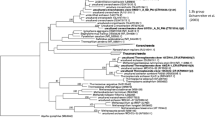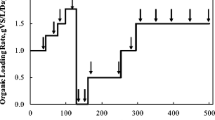Abstract
We constructed a mesophilic anaerobic chemostat that was continuously fed with synthetic wastewater containing propionate as the sole source of carbon and energy. Steady-state conditions were achieved below the critical dilution rate of 0.3 d −1 with almost complete substrate degradation. The propionate-degrading methanogenic communities in the chemostat at dilution rates of 0.01, 0.08, and 0.3 d −1 were analyzed using molecular biological techniques. Fluorescence in situ hybridization with archaeal and bacterial domain-specific probes showed that archaeal cells predominated throughout the three dilution rates. Archaeal-16S rRNA gene clone library analysis and quantitative real-time polymerase chain reaction studies showed that hydrogenotrophic methanogen rRNA genes closely related to Methanoculleus was detected at a dilution rate of 0.01 d −1, whereas rRNA genes closely related to the Methanoculleus and Methanospirillum genera were detected at dilution rates of 0.08 and 0.3 d −1. The aceticlastic methanogen, Methanosaeta, was detected throughout the three dilution rates. Bacterial-rRNA gene clone library analysis and denaturing gradient gel electrophoresis demonstrated that rRNA genes affiliated with the genus Syntrophobacter predominated at the low dilution rate, whereas rRNA genes affiliated with the phylum Firmicutes predominated at the higher dilution rates. A significant number of rRNA genes affiliated with the genus Pelotomaculum were detected at dilution rate of 0.3 d −1. The diversity of genes encoding acetate kinase agreed closely with the results of the rRNA gene analysis. The dilution rates significantly altered the archaeal and bacterial communities in the propionate-fed chemostat.







Similar content being viewed by others
References
Alfreider A, Vogt C, Babel W (2002) Microbial diversity in an in situ reactor system treating monochlorobenzene contaminated groundwater as revealed by 16S ribosomal DNA analysis. Syst Appl Microbiol 25:232–240
Altschul SF, Madden TL, Schäffer AA, Zhang Z, Miller W, Lipman DJ (1997) Gapped BLAST and PSI-BLAST: a new generation of protein database search programs. Nucleic Acids Res 25:3389–3402
Amann RI (1995) In situ identification of micro-organisms by whole-cell hybridization with rRNA-targeted nucleic acid probes. In: Akkermans ADL, Elsas JD, de Bruijin FJ (eds) Molecular microbial ecology manual, section 3.3.6. Kluwer, Dordrecht, pp 1–15
Amann RI, Binder BJ, Olson RJ, Chisholm SW, Devereux R, Stahl DA (1990) Combination of 16S rRNA-targeted oligonucleotide probes with flow cytometry for analyzing mixed microbial populations. Appl Environ Microbiol 56:1919–1925
Amann RI, Ludwig W, Schleifer KH (1995) Phylogenetic identification and in situ detection of individual microbial cells without cultivation. Microbiol Rev 59:143–169
Boone DR, Bryant MP (1980) Propionate-degrading bacterium,Syntrophobacter wolinii sp. nov. gen. nov., from methanogenic ecosystems. Appl Environ Microbiol 40:626–632
Boone DR, Whitman WB, Koga Y (2001) Order III.Methanosarcinales ord. nov. In: Boone DR, Castenholz RW (eds) Bergey’s manual of systematic bacteriology (theArchaea and the deeply branching and phototrophic bacteria), vol 1, 2nd edn. Springer, Berlin Heidelberg New York, pp 268–294
Buss KA, Cooper DR, Ingram-Smith C, Ferry JG, Sanders DA, Hasson MS (2001) Urkinase: structure of acetate kinase, a member of the ASKHA superfamily of phosphotransferases. J Bacteriol 183:680–686
Chen S, Liu X, Dong X (2005)Syntrophobacter sulfatireducens sp. nov., a novel syntrophic, propionate-oxidizing bacterium isolated from UASB reactors. Int J Syst Evol Microbiol 55:1319–1324
Chin K-J, Hahn D, Hengstmann U, Liesack W, Janssen PH (1999) Characterization and identification of numerically abundant culturable bacteria from the anoxic bulk soil of rice paddy microcosms. Appl Environ Microbiol 65:5042–5049
Chong SC, Liu Y, Cummins M, Valentine DL, Boone DR (2002) Methanogenium marinum sp. nov., a H 2 -using methanogen from Skan Bay, Alaska, and kinetics of H 2 utilization. Antonie van Leeuwenhoek 81:263–270
Cole JR, Chai B, Marsh TL, Farris RJ, Wang Q, Kulam SA, Chandra S, McGarrell DM, Schmidt TM, Garrity GM, Tiedje JM (2003) The Ribosomal Database Project (RDP-II): previewing a new autoaligner that allows regular updates and the new prokaryotic taxonomy. Nucleic Acids Res 31:442–443
de Bok FAM, Stams AJM, Dijkema C, Boone DR (2001) Pathway of propionate oxidation by a syntrophic culture of Smithella propionica and Methanospirillum hungatei . Appl Environ Microbiol 67:1800–1804
de Bok FAM, Harmsen JM, Plugge CM, de Vries MC, Akkermans ADL, deVos WM, Stams AJM (2005) The first true obligately syntrophic propionate-oxidizing bacterium,Pelotomaculum schinkii sp. nov., cocultured withMethanospirillum hungatei , and emended description of the genusPelotomaculum . Int J Syst Evol Microbiol 55:1697–1703
Erkel C, Kemnitz D, Kube M, Ricke P, Chin K-J, Dedysh S, Reinhardt R, Conrad R, Liesack W (2005) Retrieval of first genome data for rice cluster I methanogens by a combination of cultivation and molecular techniques. FEMS Microbiol Ecol 53:187–204
Felsenstein J (1985) Confidence limits of phylogenesis: an approach using the bootstrap. Evolution 39:783–791
Ferry JG (1993) Fermentation of acetate. In: Ferry JG (ed)Methanogenesis . Chapman & Hall, New York, pp 304–334
Hales BA, Edwards C, Ritchie DA, Hall G, Pickup RW, Saunders JR (1996) Isolation and identification of methanogen-specific DNA from blanket bog peat by PCR amplification and sequence analysis. Appl Environ Microbiol 62:668–675
Harmsen HJM, Akkermans ADL, Stams AJM, De Vos WM (1996) Population dynamics of propionate-oxidizing bacteria under methanogenic and sulfidogenic conditions in anaerobic granular sludge. Appl Environ Microbiol 62:2163–2168
Harmsen HJM, Van Kuijk BLM, Plugge CM, Akkermans ADL, De Vos WM, Stams AJM (1998)Syntrophobacter fumaroxidans sp. nov., a syntrophic propionate-degrading sulfate reducing bacterium. Int J Syst Bacteriol 48:1383–1387
Houwen FP, Plokker J, Stams AJM, Zehnder AJB (1990) Enzymatic evidence for involvement of the methylmalonyl-CoA pathway in propionate oxidation. Arch Microbiol 155:52–55
Hugenholtz P, Pitulle C, Hershberger KL, Pace NR (1998) Novel division level bacterial diversity in a Yellowstone hot spring. J Bacteriol 180:366–376
Imachi H, Sekiguchi Y, Kamagata Y, Ohashi A, Harada H (2000) Cultivation and in situ detection of a thermophilic bacterium capable of oxidizing propionate in syntrophic association with hydrogenotrophic methanogens in a thermophilic methanogenic granular sludge. Appl Environ Microbiol 66:3608–3615
Imachi H, Sekiguchi Y, Kamagata Y, Hanada S, Ohashi A, Harada H (2002)Pelotomaculum thermopropionicum gen. nov., an anaerobic, thermophilic, syntrophic propionate-oxidizing bacterium. Int J Syst Evol Microbiol 52:1729–1735
Ingram-Smith C, Barber RD, Ferry JG (2000) The role of histidines in the acetate kinase fromMethanosarcina thermophila . J Biol Chem 275:33765–33770
Kida K, Morimura S, Sonoda Y (1993) Accumulation of propionic acid during anaerobic treatment of distillery wastewater from barley-shochu making. J Ferment Bioeng 75:213–216
Kida K, Shigematsu T, Kijima J, Numaguchi M, Mochinaga Y, Abe N, Morimura S (2001) Influence of Ni 2+ and Co 2+ on methanogenic activity and the amounts of coenzymes involved in methanogenesis. J Biosci Bioeng 91:590–595
Kimura M (1980) A simple method for estimating evolutionary rates of base substitution through comparative studies of nucleotide sequences. J Mol Evol 16:111–120
Koch M, Dolfing J, Wuhrmann K, Zehnder AJB (1983) Pathways of propionate degradation by enriched methanogenic cultures. Appl Environ Microbiol 45:1411–1414
Kumar S, Tamura K, Nei M (2004) MEGA3: Integrated software for Molecular Evolutionary Genetics Analysis and sequence alignment. Briefings in Bioinformatics 5:150–163
Liu Y, Balkwill DL, Aldrich HC, Drake GR, Boone DR (1999) Characterization of the anaerobic propionate-degrading syntrophsSmithella propionica gen. nov., sp. nov. andSyntrophobacter wolinii . Int J Syst Bacteriol 49:545–556
Lueders T, Chin K-J, Conrad R, Friedrich M (2001) Molecular analyses of methyl-coenzyme M reductase α-subunit (mcrA ) genes in rice field soil and enrichment cultures reveal the methanogenic phenotype of a novel archaeal lineage. Environ Microbiol 3:194–204
Lueders T, Pommerenke B, Friedrich MW (2004) Stable-isotope probing of microorganisms thriving at thermodynamic limits: syntrophic propionate oxidation in flooded soil. Appl Environ Microbiol 70:5778–5786
Mikucki JA, Liu Y, Delwiche M, Colwell FS, Boone DR (2003) Isolation of a methanogen from deep marine sediments that contain methane hydrates, and description ofMethanoculleus submarinus sp. nov. Appl Environ Microbiol 69:3311–3316
Namiki H (1986) Testing methods for industrial wastewater, JIS K 0102-1986, Japanese Standards Association, Tokyo
Nilsen RK, Torsvik T, Lien T (1996)Desulfotomaculum thermocisternum sp. nov., a sulfate reducer isolated from a hot North Sea oil reservoir. Int J Syst Bacteriol 46:397–402
Øvreås L, Forney L, Daae FL, Torsvik V (1997) Distribution of bacterioplankton in meromictic Lake Sælenvannet, as determined by denaturing gradient gel electrophoresis of PCR-amplified gene fragments coding for 16S rRNA. Appl Environ Microbiol 63:3367–3373
Plugge C, Balk M, Stams AJM (2002)Desulfotomaculum thermobenzoicum subsp.thermosyntrophicum subsp. nov., a thermophilic, syntrophic, propionate-oxidizing, spore-forming bacterium. Int J Syst Evol Microbiol 52:391–399
Raskin L, Stromley JM, Rittmann BE, Stahl DA (1994) Group-specific 16S rRNA probes to describe natural communities of methanogens. Appl Environ Microbiol 60:1232–1240
Saitou N, Nei M (1987) The neighbor-joining method: a new method for constructing phylogenetic trees. Mol Biol Evol 4:406–425
Schink B, Stams AJM (2002) Syntrophism among prokaryotes. In: Dworkin M (ed) The prokaryotes: an evolving electronic resource for the microbiological community, 3rd edn. Springer, Berlin Heidelberg New York. http://link.springer-ny.com/link/service/books/10125 (release 3.8)
Sekiguchi Y, Kamagata Y, Syutsubo K, Ohashi A, Harada H, Nakamura K (1998) Phylogenetic diversity of mesophilic and thermophilic granular sludges determined by16S rRNA gene analysis. Microbiology 144:2655–2665
Sekiguchi Y, Kamagata Y, Nakamura K, Ohashi A, Harada H (1999) Fluorescence in situ hybridization using 16S rRNA-targeted oligonucleotides reveals localization of methanogens and selected uncultured bacteria in mesophilic and thermophilic sludge granules. Appl Environ Microbiol 65:1280–1288
Sekiguchi Y, Kamagata Y, Harada H (2001) Recent advances in methane fermentation technology. Curr Opin Biotechnol 12:277–282
Shigematsu T, Tang Y, Kawaguchi H, Ninomiya K, Kijima J, Kobayashi T, Morimura S, Kida K (2003) Effect of dilution rate on structure of a mesophilic acetate-degrading methanogenic community during continuous cultivation. J Biosci Bioeng 96:547–558
Shigematsu T, Tang Y, Kobayashi T, Kawaguchi H, Morimura S, Kida K (2004) Effect of dilution rate on metabolic pathway shift between aceticlastic and non-aceticlastic methanogenesis in chemostat cultivation. Appl Environ Microbiol 70:4048–4052
Stahl DA, Amann RI (1991) Development and application of nucleic acid probes. In: Stackebrandt E, Goodfellow M (eds) Nucleic acid techniques in bacterial systematics. Wiley, New York, pp 205–248
Tang Y, Shigematsu T, Ikbal, Morimura S, Kida K (2004) The effects of micro-aeration on the phylogenetic diversity of microorganisms in a thermophilic anaerobic municipal solid-waste digester. Water Res 38:2537–2550
Tang Y, Shigematsu T, Morimura S, Kida K (2005) Microbial community analysis of mesophilic anaerobic protein degradation process using bovine serum albumin (BSA)-fed continuous cultivation. J Biosci Bioeng 99:150–164
Thauer RK, Hedderich R, Fischer R (1993) Reactions and enzymes involved in methanogenesis from CO 2 and H 2 . In: Ferry JG (ed)Methanogenesis . Chapman & Hall, New York, pp 209–252
Thompson JD, Gibson TJ, Plewniak F, Jeanmougin F, Higgins DG (1997) The CLUSTAL_X windows interface: flexible strategies for multiple sequence alignment aided by quality analysis tools. Nucleic Acids Res 24:4876–4882
Wagner M, Roger AJ, Flax JL, Brusseau GA, Stahl DA (1998) Phylogeny of dissimilatory sulfite reductases supports an early origin of sulfate respiration. J Bacteriol 180:2975–2982
Wallrabenstein C, Hauschild E, Schink B (1995)Syntrophobacter pfennigii sp. nov., new syntrophically propionate-oxidizing anaerobe growing in pure culture with propionate sulfate. Arch Microbiol 164:346–352
Wofford NQ, Beaty PS, McInerney MJ (1986) Preparation of cell-free extracts and the enzymes involved in fatty acid metabolism inSyntrophomonas wolfei . J Bacteriol 167:179–185
Yumihara K, Shigematsu T, Hamada K, Morimura S, Kida K (2002) Anaerobic degradation of terephthalic acid and aniline by methanogenic consortia. Jpn J Water Treat Biol 38:1–9
Zeikus JG (1977) The biology of methanogenic bacteria. Bacteriol Rev 41:514–541
Zellner G, Messner P, Winter J, Stackebrandt E (1998)Methanoculleus palmolei sp. nov., and irregularly coccoid methanogen from an anaerobic digester treating wastewater of a palm oil plant in North-Sumatora, Indonesia. Int J Syst Bacteriol 48:1111–1117
Zinder SH (1993) Physiological ecology of methanogens. In: Ferry JG (ed)Methanogenesis . Chapman & Hall, New York, pp 128–206
Acknowledgements
This study was financially supported by a Grant-in-Aid for Scientific Research (Project Nos. 14580593 and 16510061) from the Japan Society for the Promotion of Science (JSPS). The authors thank Katsumi Kai at Kumamoto University for excellent technical assistance.
Author information
Authors and Affiliations
Corresponding author
Rights and permissions
About this article
Cite this article
Shigematsu, T., Era, S., Mizuno, Y. et al. Microbial community of a mesophilic propionate-degrading methanogenic consortium in chemostat cultivation analyzed based on 16S rRNA and acetate kinase genes. Appl Microbiol Biotechnol 72, 401–415 (2006). https://doi.org/10.1007/s00253-005-0275-4
Received:
Revised:
Accepted:
Published:
Issue Date:
DOI: https://doi.org/10.1007/s00253-005-0275-4




